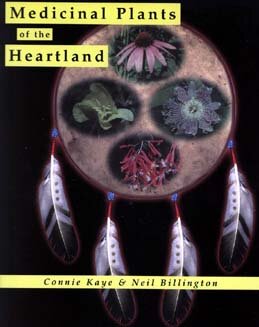Journal Contents Back Issues Book Reviews Research Notes Careers Meetings Botany Resources
![]()
Journal Contents Back Issues Book Reviews Research Notes Careers Meetings Botany Resources
![]()

Dr. Connie Kaye worked 10 years as a medical technologist before specializing in botany (effect of plant growth regulators on expression of ribosomal cistrons). Two of her ancestors were Cherokee Indians and she obtained some interest in medicinal plants from them. Some of her other sources are listed in the bibliography (51 citations).
Dr. Neil Billington, presently a Southern Illinois University Cooperative Fisheries researcher began expanding his interest in medicinal plants through his work in a wholefood cooperative, in a culinary and medicinal plant garden in Shepshed, and eight years of study of the use of medicinal plants by Canadian Indians and Inuit.
The authors, now health-advice givers, describe the uses of plants as medicines, flavorings, preservatives, cosmetics, and others. Their book is an educational reference manual--everything one wanted to know about the heartland's medicinal plants. If seventeen Indian tribes used these plants, what have we got to lose by learning about these plants. So, they tell us of their medicinal actions. They list 37--from alternative to vulnerary.
Kaye and Billington begin their book with historical perspectives of human health preventatives and treatments: from the pagan and superstitious to the modern. They help us create our own apothecary if we wish to do so. Chapters three and four deal with collecting, drying and storing medicinal plants; their parts and preparations therefrom (remedies from compresses to tinctures). To help, an appendix contains information on 91 active compounds from ferns, grasses, cacti, wild herbs, cultivated herbs, etc. The book reviews about 250 plants and their active components (from alkaloids to tannins). Over 150 drawings and 90 color plates enhance the descriptions. Many photos are from the Walter Welch collection in the SIU Herbarium. Over 160 disorders (from ague to whooping cough)and the herbal treatments for each (medicinal functions) are given. Botanical names and medicinal terms abound.
Galen's recipes or the words of Druid songs describing treatments could not do more than this book to help heal us in times of need. Natures pharmacopoeia! Ancient treatments! Past secrets. Its economic botany. Its ayurved (the science of life). Maybe it won't replace surgery and like but many people will buy it in these times. In our opinion, it will interest many and make a fine gift to those who enjoy herbal health stores and economic botany at work.
A.J.P.